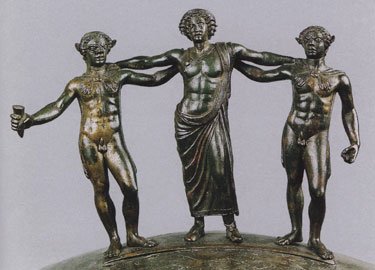Scythian Art at the British Museum
Ancient Art, British Museum, Scythians
——————————————-
———————————————
London Review of Books, At the British Museum:
Herodotus tells us that when Darius’ Persian army invaded Scythia, in the late sixth century bce, the Scythians ran away. The Persians followed them over the steppeland north of the Black Sea until, tiring of the pursuit, Darius sent a messenger to the Scythian king to tell him to make a stand or bend the knee. The Scythian king, Idanthyrsus, informed the messenger that as they had no cities or crops they had nothing to defend and could therefore afford to exhaust the Persians by making them traipse across the land. They would fight only if the Persians tried to loot their graves: ‘Attack those graves and you will soon discover whether we are fighters or not!’ Eventually, his army sickening and hungry, Darius gave up and returned to Persia.
Nomadic civilisations pose many of the same difficulties to archaeologists as they do to invading armies. They are difficult to pin down. For one thing the Scythians weren’t so much a people as some peoples. The term ‘Scythians’ is a collective name for a number of migratory tribes who spoke early Iranian dialects and enjoyed a similar lifestyle, culture, economy and set of beliefs. Between 800 bce and 300 bce, roughly speaking, these tribes roamed a vast expanse of land stretching from Central Asia in the east to the Hungarian plain in the west (an area that would include parts of south-west Russia, Ukraine and Kazakhstan today). They were wealthy, allegedly because they controlled the slave trade between Northern Europe and Greece. But being illiterate they left no manuscripts, and being nomadic no ruins. There are accounts of them written by non-Scythians, Herodotus most prominently, but a lot of what we know about them we know because the graves they were so keen to defend have been ransacked and their contents – in many cases well preserved by permafrost – brought to light.
These graves, or kurgans (their Slavic name), provided rich pickings for grave-robbers until looting them was made illegal by Peter the Great in the early 18th century. It was Peter the Great who commissioned the first archaeological excavations of Scythian tombs and his Siberian Collection, on which much of our knowledge of Scythian material culture depends, contains around 240 gold artefacts. One of the most famous pieces of Scythian art and the first exhibit in the British Museum’s current show (until 14 January 2018) is a fourth-century gold belt buckle from Peter’s collection, 16 cms wide and 12 cms tall, which depicts two men in low relief sitting with a dead comrade beneath a tree. The man on the right holds the reins of two horses while the man on the left cradles the head of his dead friend, who lies on the ground in a suit of armour looking a lot like the sculpture of a dead knight one might find on a medieval tomb. A quiver of arrows hangs from the tree. The leaves, horses’ heads and quiver all droop downwards giving the impression that the whole scene is sinking into the earth, drawn by the gravity of death.








